Winnie was the first whale I ever saw in the flesh – or perhaps that should be “in the blubber”?
Not that my four-year-old brain had any concept of size back then, but Winnie was a 14.5ft long killer whale, weighing a little under 2 tonne. She performed up to seven times a day in the Windsor Safari Park dolphinarium pool, which was 85ft long, 46ft wide and 11.5ft deep.
When she wasn’t entertaining the “Great” British public, Winnie was kept in a side pool that was just twice her length (32ft long, 25ft wide and 9.5ft deep).
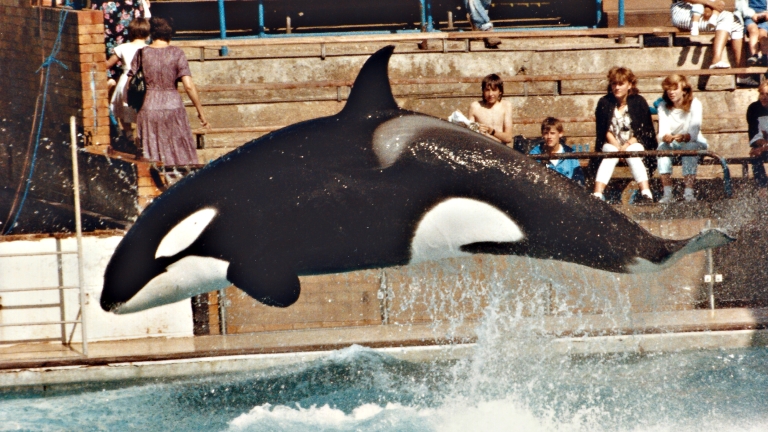
The notion that it was inhumane to hold such a large, wild animal in such a small enclosure was also lost on my naive mind – as it probably was on those of many Brits in the 80s.
We didn’t need to jet off to Florida or California to see the infamous Shamu show at SeaWorld; we had Windsor Safari right on our doorstep. And the chance to see a real whale, in person, was one that couldn’t be missed. Seeing a whale was a dream.
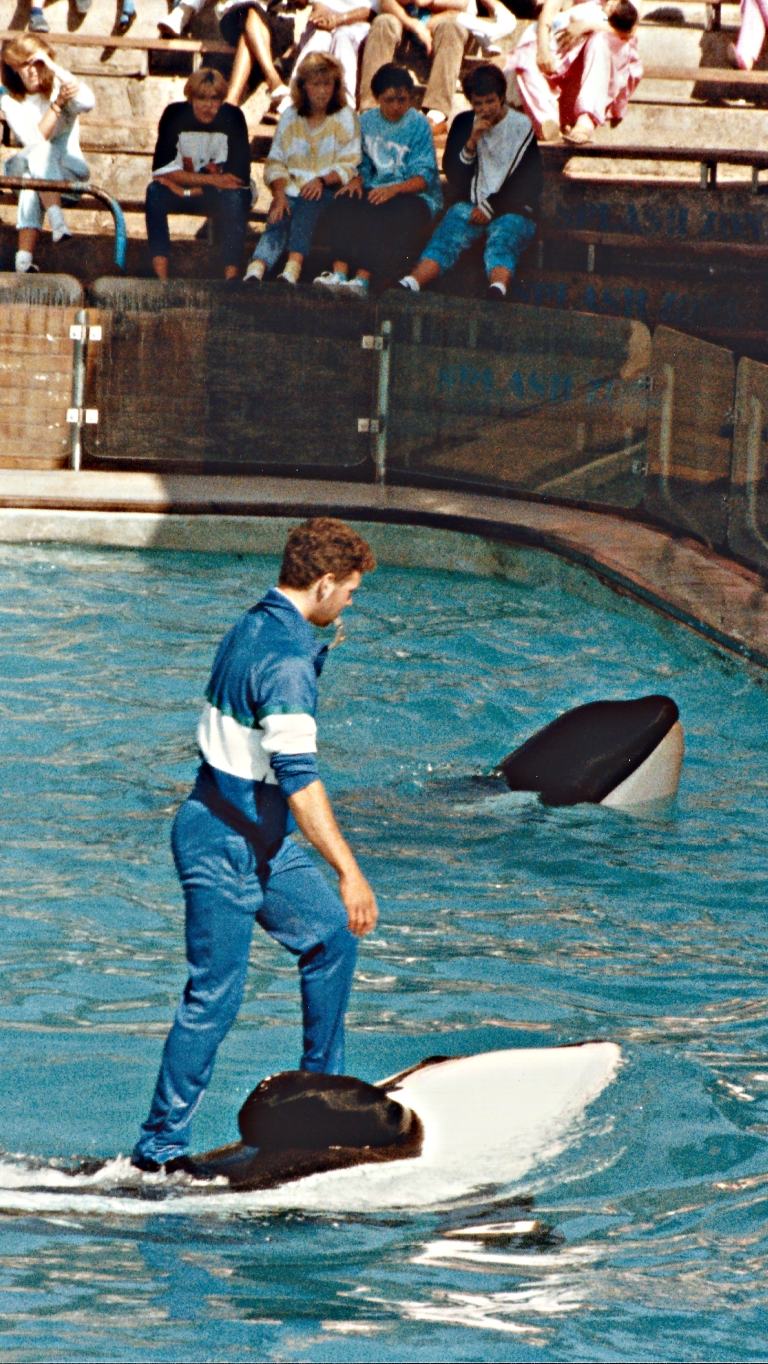
Captive killer whales: dying to entertain us.
Half starved (unbeknown to me at the time) and “rewarded” with buckets of fish, I watched Winnie respond to whistled commands from her trainer: she swam the perimeter of the pool, flicked a football, gave the trainer a kiss, surfed the trainer from one side of the pool to the other, waved goodbye to everyone, then came back as an encore to splash those sat in the Splash Zone with a predictable-but-still-surprising belly flop.
There were cheers and clapping, then we left. Herded into the gift shop, I was allowed to pick one souvenir – I chose a small Winnie stuffed toy.
Though I still have my Winnie toy nearly 30 years later, my memory of her performance is hazy. I don’t remember how many people sat on the benches watching the show with me that day – but reading up on the history of Windsor Safari Park while writing this post, I doubt it was many.
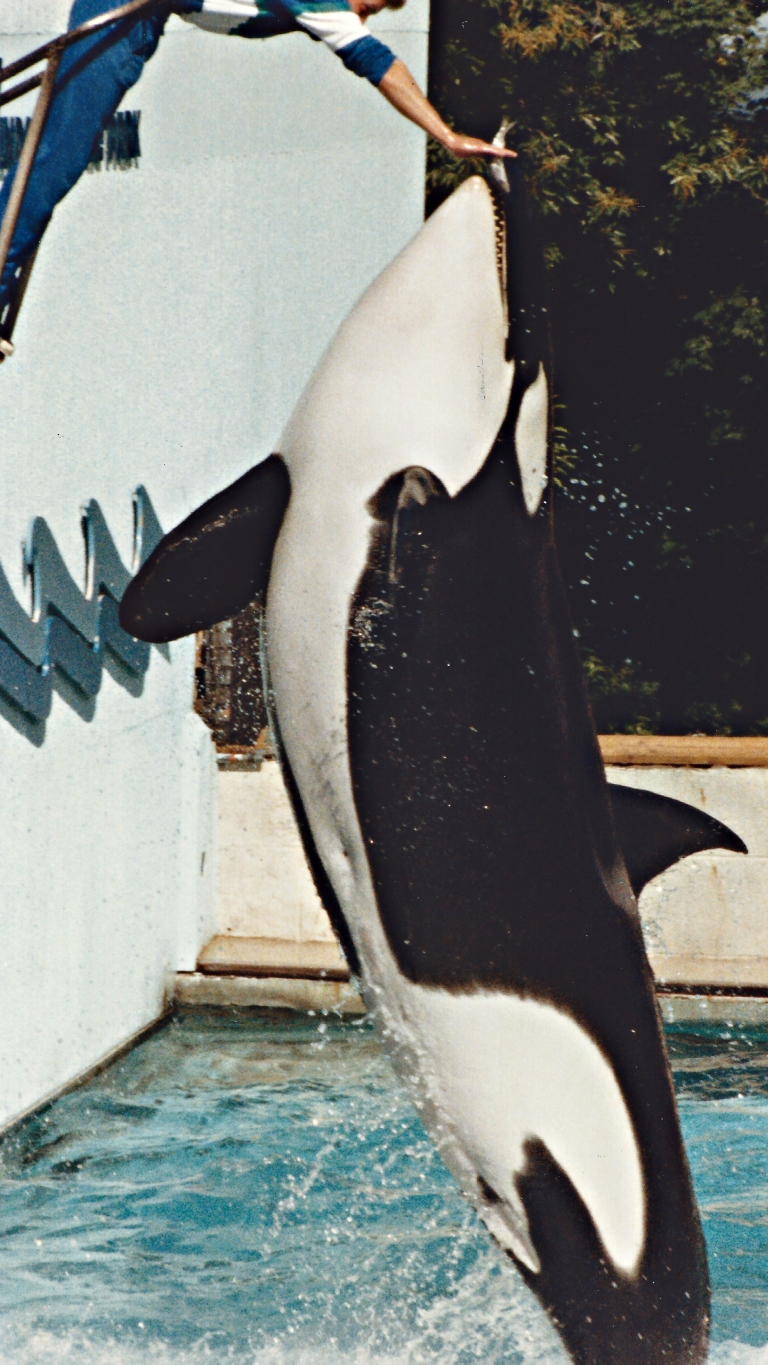

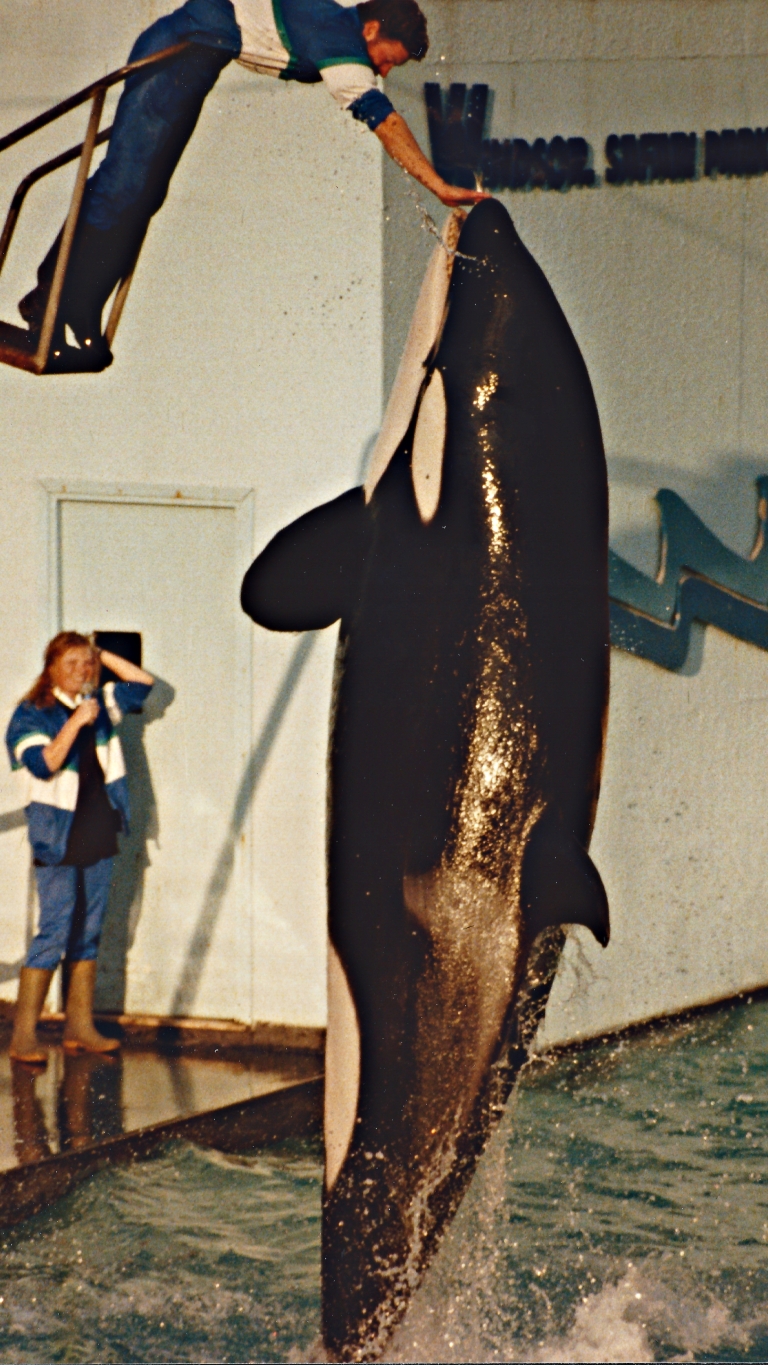
The beginning of the end for Windsor Safari Park.
Originally opened in 1969, visitor numbers to the Park had been dwindling since the mid 80s. More and more families holidayed abroad during the summer months, and those that didn’t chose days out at amusement parks over zoos and safaris.
Mounting pressure from animal activists and Greenpeace lobbyists didn’t help the situation either.

Sensing the cultural shift, local rival Chessington Zoo began building a shiny new addition to meet the demand: a £12million state-of-the-art theme park. Chessington reopened on 7 July 1987 (coincidentally, at the same time as the M25 motorway opened) with a name change: Chessington World of Adventures.
Windsor Safari Park could not compete. And following the success of animal rights campaign “Into The Blue”, the UK government made standards of care for marine mammals in captivity so stringent, no dolphinarium in the country could afford to meet them. So, one by one, they shut down.
The UK’s last dolphinarium was Windsor Safari Park.
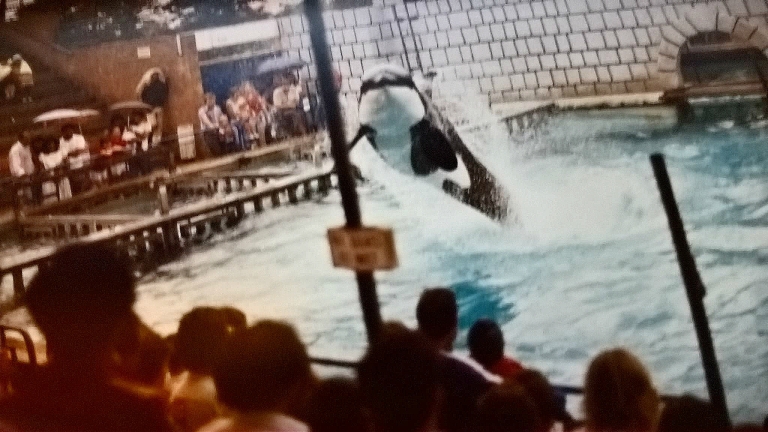
The strict new regulations about the size of pools meant star attraction Winnie – who had resided at Windsor since 1977 – had to find a new home. The Park didn’t have the funds to extend her enclosure, so she was shipped to SeaWorld Orlando in 1991.
Unfortunately Winnie’s tragic life didn’t get much better across the pond; the submissive orca was bullied by younger whales that were much bigger than her. Experts said that being kept in such a small pool in Windsor had stunted Winnie’s growth during her early years, though she did gain some weight in the US (doesn’t everyone?).
Winnie sadly passed away in 2002; a necropsy found that she’d consumed over 12lb of indigestible debris (including British coins and broken tiles from the tank in Windsor) during her 26 years, which caused her intestines to become blocked and stop working.
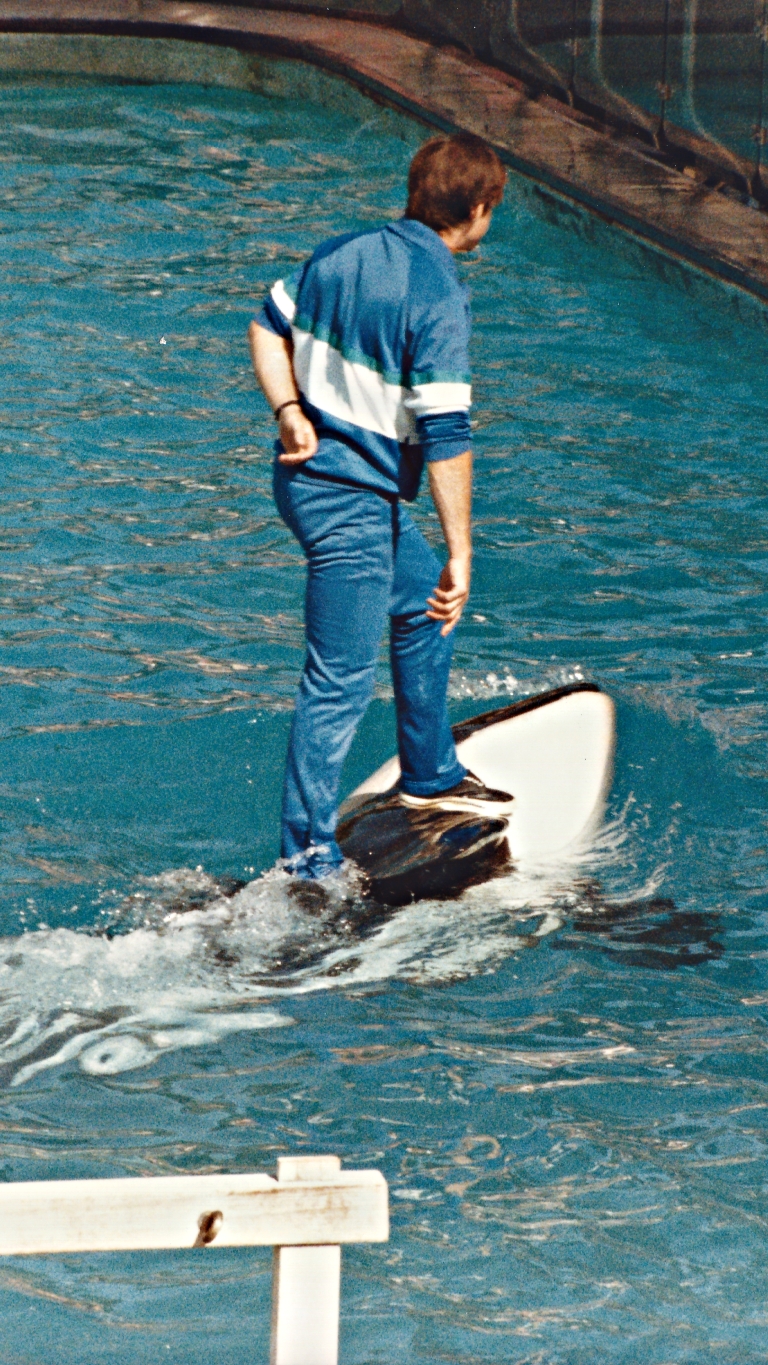
What happened to Windsor Safari Park?
Well, without Winnie there were no visitors, and without visitors there was no money coming in. The Park opened its gates for the last time on Sunday 25 October 1992, and was then taken into receivership the next day. Its owners owed debts of £40million, and without a benefactor willing to swoop in and give the Park a vital cash injection, it closed indefinitely.
Some of the animals – which included 34 lions, seven elephants, 45 baboons, seven tigers, 13 wolves and eight dolphins – were rehomed at other zoos and safari parks around the UK. Sadly, however, newspaper coverage at the time reported that the animals that couldn’t be rehomed (because of old age or illness) were euthanised. With no dolphinariums left in the UK, Windsor Safari Park’s dolphins went to the Netherlands.
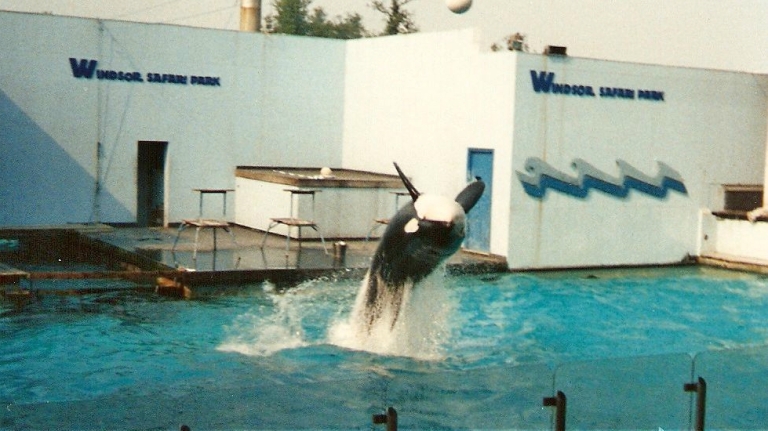
Fast forward four years and the gates to the Park were once again open, though in an entirely new guise. The animals that once lived there were forgotten, and the whale shows that had entertained families for over three decades were a distant memory. Windsor Safari Park had been completely redeveloped into, what is now, the UK’s most visited theme park: Legoland Windsor.
The only animals on display now are those made from colourful, plastic bricks – proving that the British public don’t want or need performing orcas and marine mammal acrobatics as a form of entertainment.

*****
I’m from a family of animal lovers. I grew up surrounded by dogs, cats, rodents, fish and birds (there are currently chickens and turtles at my parents’ house, too).
While my school pals idolised pop stars and watched Byker Grove, Grange Hill and the latest Disney movies, I was watching The Animals of Farthing Wood, Animal Hospital and films like Ring of Bright Water. When I was older I wanted to be Michaela Strachan or Virginia McKenna, rescuing and rehabilitating animals. As mentioned in a previous post about the charity Save a Gato, I even named my first pet – a little white kitten – after Elsa the lioness from the Born Free trilogy.
Another childhood favourite was Free Willy; I wore the VHS out watching it over and over. Even now as an adult, the fictitious story of Jesse’s commitment to helping his 4.5 tonne (notice the difference in size between him and Winnie) cetacean friend escape captivity and return to the open ocean has me on an emotional roller coaster, with tears of joy and sadness interspersed with feelings of anger and triumph.
The end scenes of Willy swimming freely with a pod of wild killer whales have stuck in my mind for over 20 years. Ever since I first watched the film, going whale watching to see these magnificent creatures in their own environment – not just from the confines of what amounts to a giant bath tub – has been on my bucket list.

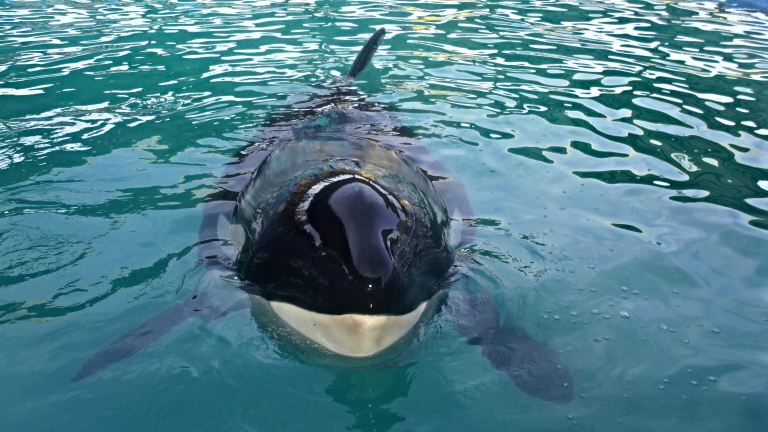
From bath tub to bucket list.
Though I’ve never been to an official SeaWorld park (and have now vowed I never will), in 2009 my parents and I visited Miami Seaquarium on a family holiday to Florida. I do recall niggles of guilt at the back of my mind for being a person who paid money to keep a 22ft long orca in a tank, but the presenter did a great job in convincing everyone that the huge mammal was happy and content. So I watched Lolita the killer whale splash around her pool entertaining the visitors, reminiscing about my childhood trip to Windsor Safari Park.
It’s only as an adult, as I read and learn more and more about travel and the tourism industry, that I truly understand what animals in captivity go through, and how our entertainment is so often at the expense of the animal’s health and mental well-being. Last year for example, as Hurricane Irma ravaged the US East Coast, drone footage emerged of an abandoned Lolita, left alone and exposed to the elements, with no shelter from falling debris. My anger at Miami Seaquarium, and my own remorse at having visited somewhere that treats animals so inhumanely, is insurmountable.
Bad enough that captive orca exist, but unlike other animals they can’t be evacuated during #Irma. Barbaric that Lolita has been abandoned. pic.twitter.com/jDLbIq9lw3
— Anna MacLaughlin (@AnnaGraceMac) September 9, 2017
Recently I watched a documentary on the real Free Keiko story and found out about the Free Willy-Keiko Foundation set up by Warner Bros. If you’re interested, you can watch the documentary here, but word of warning, have tissues at the ready.
But it was an unpredictable and overwhelming documentary on Netflix that I watched in 2013 that really changed my mindset:
The “Blackfish effect”.
Low-budget documentary Blackfish had a far greater impact than its producers and director ever thought it would. It opened the public’s eyes to the way captive killer whales (and other cetaceans) are treated, housed and cared for.
The film drew wider attention to Dawn Brancheau’s death in 2010. Dawn was SeaWorld’s most experienced trainer, working with Tilikum, the company’s biggest killer whale (and the largest captive orca in the world until his death in January 2017). During a routine show she was pulled into the water by 6.7 tonne Tilikum and drowned, while a traumatised audience looked on. Blackfish revealed that Dawn’s was not the first death linked to Tilikum, however. If you haven’t seen it, the documentary is available on Netflix and well worth a watch.
After the film’s release in June 2013, mounting protests against the holding of orca in captivity, an overnight drop in share prices and the continued decrease in visitor numbers saw SeaWorld report a loss of $25.4million in the fourth quarter of that year. And as of January 2017, SeaWorld’s shares have dropped by half since 2013.
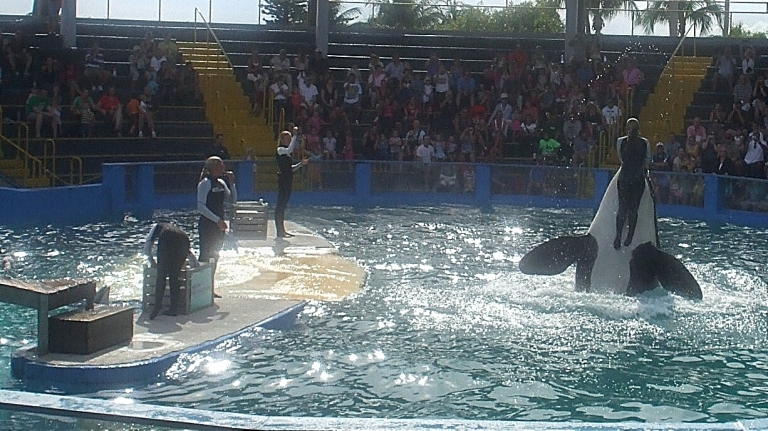
While the downturn of the American institution’s fortunes can almost entirely be ascribed to Blackfish, SeaWorld has responded to public pressure. In March 2016, it announced it would end its orca breeding programme, making its current captive killer whales “the last generation of orcas in SeaWorld’s care”. In an attempt to rebrand from an entertainment company to a conservation company, it also announced it would be phasing out the daily theatrical performances and introducing “new, inspiring, natural orca encounters, focusing on orca enrichment, exercise and overall health.”
It hasn’t just been SeaWorld which has been caught up in the “Blackfish affect”, though. Other businesses in the tourism industry have also responded to the public backlash; in July 2014, Southwest Airlines stated it would not be renewing its partnership with SeaWorld. And most recently, (my favourite) British travel company Thomas Cook announced it would stop selling tickets to SeaWorld as part of its holiday packages.

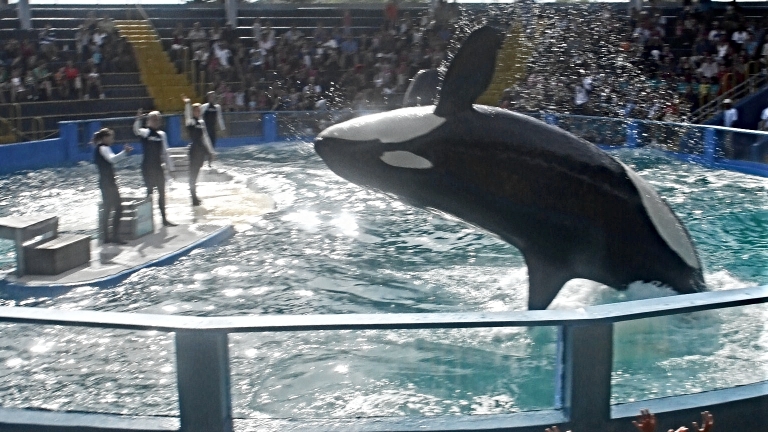
Like many others that have watched Blackfish, I have vowed firmly to never again pay to watch whales, dolphins and other marine animals perform.
My dreams of seeing these majestic creatures in their natural environment are very much still alive, though. And through everything I read about various species becoming endangered (or worse, extinct in the wild), I’m even more determined to tick whale watching off my bucket list, before it’s too late.
In fact, it very nearly happened earlier this year. When I was in Iceland at the end of March, I went on a whale watching boat trip with Special Tours. But that’s a post for another day…
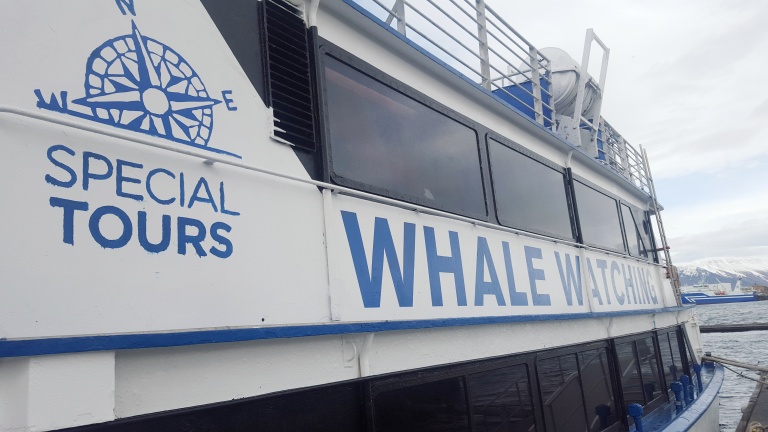
*****
Note: Windsor Safari Park photos in this post have kindly been shared by Norman Griffin, Barbara Todd and Colette Buchanan-Grey, and were all taken between 1982-89. Miami Seaquarium pictures my own, regrettably.

oh wow. i never knew this. thank you for sharing.
LikeLiked by 1 person
Interesting post! I’m very vocal in animal rights (currently listening to a podcast about the very subject as we type this!) but about 9 years ago I did ‘play with dolphins’ in Mexico. I didn’t even think about it at the time, and thought that they looked happy so it was all good. Luckily now I know better. I don’t think we should beat ourselves up for these things, because the world as a whole didn’t think about these issues until very recently. But we can collectively refuse to, now we know the truth, not visit these establishments which will make a big change for the better, I’m sure. I’m really glad you posted this, thanks for raising awareness!
LikeLiked by 1 person
Thanks for your comment Claire – I appreciate you taking the time to share your own experiences. I have also swam with dolphins, when I was in Cuba with an ex-boyfriend. It was slightly different in the sense that these dolphins were in the sea rather than a tank – they were ex-SeaWorld dolphins, which were being reintroduced into the wild, but through illness/inability to reintegrate properly, were kept in a very big enclosure off the coast. I do feel a slight sense of guilt, but at the same time, these dolphins were very happy to be interacted with! x
LikeLike
I too remember visiting a sea park in the 80’s. One of my fondest memories as a child celebrating a birthday with my father (my father passed a few years later and we had an amazing day that day). I often trace it back to some of the earliest inspiration for my life long love of all things ocean. Of course, as we grow we learn to do better. Know better, do better. So I have taken my own boys to many of the US’ finest aquariums to help plant to seed of love of ocean life in them…
LikeLiked by 1 person
Seeing these creatures in the wild is truly amazing. You need to check that off your bucket list. My advice is to find the smallest boat possible. On day, while kayaking off the coast of San Diego, a humpback whale surfaced right next to our boat. I can remember the sound he made coming up and exhaling his big breath. There wasn’t a motor within a mile of this beauty and we got to experience it all.
LikeLiked by 1 person
WOW! What an amazing experience you guys had 🙂 have you got any pictures? I’d love to see 🙂 x
LikeLike
Orcas are such magnificent creatures, aren’t they? I’ve only ever seen them in the wild (funny we should both post about orcas on the same day!). Come to Shetland to fulfil that bucket list dream of seeing them in their natural habitat! 🙂
LikeLiked by 1 person
Oh my goodness, I didn’t even know you could see Orcas in the UK in the wild! I must make a visit to The Shetland Isles 😉 x
LikeLike
It’s so horrific what happened to these beautiful captured creatures. I’m just glad that these will be the last generation in this barbaric industry. I feel so bad for poor orcas like Winne – I didn’t know her growth was stunted by the pool size.
LikeLiked by 1 person
It’s so sad, especially when you compare her size to that of other killer whales in captivity that had much larger tanks 😦 I say “much larger”, but none are ever going to be as large as their natural habitat 😦 x
LikeLike
Such a sad, cautionary story about whether and how people should mess around with the animal kingdom. I was convinced by you to be official in my stance not to give my business to attractions that hold these majestic creatures captive. I, like you, would love to see them in their natural habitat. I went whale watching once, but none showed up. 😦
LikeLiked by 1 person
Snap – we will just have to go whale watching again and hope we see these majestic creatures in their natural environment x
LikeLike
It’s not that long ago that everyone found it normal to see animals in small habitats in the zoo – but I am glad those rules became stricter – although it meant that in our Antwerp zoo the dolphin show had to go too 😮
LikeLiked by 1 person
When I was a child, my parents took us to Windsor Safari Park to see the Winnie the killer whale. Looking back now, it’s upsetting how she had to perform several times a day to entertain the public and be kept in a tiny pool. Like you, Ian and I will never pay to watch animals perform. Whilst on our Australia road trip, we were lucky to spot whales in the far distance. I’ve not been on a boat to go whale watching, hopefully one day I’l get the chance.
LikeLiked by 1 person
Yeah I know what you mean Lana – hindsight is a wonderful thing isn’t it, I just wish we knew back then what we know now. I guess it’s how we change things (society’s behaviour and attitude to keeping whales in captivity) knowing what we do now that matters x
LikeLike
As kids we never realised (nor did our parents) what torture the animals we went to see in circuses went through. Captivity kills. Zoos are prisons and SeaWorld needs to perish. As someone who loves animals, detests cruelty, and tries my best to be a responsible traveller I prefer to visit sanctuaries where animals rescued from cruel and inhumane situations have been rehabilitated. I visited one such organisation called Wildlife SOS in India and wrote about it on my blog. And I would love to go whale watching as long as the tour provider respects the guidelines for staying at a respectful distance from the whales and not crowding them in the waters.
LikeLiked by 1 person
You’re totally right Priya – respecting the animals natural habitat is a must! x
LikeLike
Knowing the conditions Winnie was kept in and how she died is sad indeed, and she is not alone. Although seeing captive animals often instills a passion in young children which can lead to interests in study and conservation, it is awful realize mistreatment is the norm in many cases.
I grew up about 50 miles from Sea World in Cleveland, Ohio. I do not remember too much going there as a child – not the killer whales, anyway
LikeLiked by 1 person
Thanks for your comment Fiona – I think you’re right, seeing an animal in captivity, like a whale, tiger or elephant, during childhood can spark a passion in a young, impressionable mind. But seeing that animal in the wild would definitely be better than in captivity 🙂 x
LikeLike
I grew up in Berkshire but as I was 2 when the place closed I’m guessing that is why I never knew it existed or was in the legoland location. I’m on the fence when it comes to animals in captivity as I have my own opinions on the matter but I think as long as enclosures are large enough and animals are not mistreated then I agree with them. I love animals but I also like being able to take my children to Zoo’s and such to see animals they may never see x
LikeLiked by 1 person
I hear you Jade, but how can you ever be sure that their enclosures are big enough? Nothing is going to be as big as the space they have in the wild… x
x
LikeLike
What a super sad story. I went to visit Sea World in San Diego when I was a kid and of course you never think about those things when you are little. I’m glad that those parks do not exist anymore because of the horrible cruelty to those animals.
LikeLiked by 1 person
Such a sad story, unfortunately, we as kids are never exposed to what goes on behind the scenes with the creatures we grow to love.
LikeLiked by 1 person
You kinda said it! Though it looks entertaining at first, I’m pretty sure, the animals don’t feel that way. About time we thought of their perspectives too!
LikeLiked by 1 person
Totally – I wonder what the future will hold for places like SeaWorld!? x
LikeLike
It’s a very sad story, but as kids we don’t understand how are we hurting those beautiful creatures. We believe that they are having fun because we are having fun. I am glad that such tortures are coming to an end.
LikeLiked by 1 person
I am so happy to read that times have changed and the well being of dolphins have improved drastically
LikeLiked by 1 person
Thanks for doing your part in raising awareness of this industry. Like you I remember seeing Winnie, but I felt so saddened by how couped up she was. I remember them sending a little girl from the audience across the pool in a dingy. I like you also reluctantly visited sea world in Florida with a friend…I felt such guilt at the time, but it moved me to take action. I then started writing letters and questioning them on their animal welfare. I joined the whale and dolphin conservation society where I could obtain information and documents about these parks, so I could hammer them with direct questions. The more recent black fish video included some of these issues. I’m glad it exposed these parks. Animals , like humans deserve freedom . No animal should be a slave to an owner. Unfortunately sea world responded to public uproar by introducing their own breeding programme rather than capturing them. Most of these majestic animals will never be re released because they would not survive. I enjoyed reading your well balanced view. They are awe inspiring to watch but better to do it in the natural environment.
LikeLiked by 1 person
Thanks so much for you comment Marianne – it’s nice to hear from another person who visited the park and shares the same feelings of regret and guilt, while also treasuring memories of the place. Only time will tell how things will pan out for SeaWorld, but I definitely think that awareness is the key here x
LikeLike
Its very heart touching post. I too enjoyed this sometimes ago until recently we all realize that how we are trying to change nature. I must say your post is very meaningful
LikeLiked by 1 person
I hope your post reminds people that they shouldn’t be supporting Seaworld nor anything else similar. I’m still so shocked when I see people from Windsor’s posts online posing with drugged up lions or tigers or them swimming with captive dolphins 🙄😣
LikeLiked by 1 person
This is beautifully written. Made me tear up some. I grew up going to Seaworld. We lived about an hour from Orlando. So, I, too have been part of watching these animals perform in captivity. So sad, but it seems like things are at last changing for them because of voices like yours.
LikeLiked by 1 person
I grew up in Surrey, not too far away from Windsor Safari Park. I also have a very vague memory of visiting it when I was younger – although I don’t remember seeing killer whales there. It was so long ago now though, so who knows!
My main memory of our visit was that my parents lied about my age because children under a certain age (like 5 or something) went in for free. I was a few years older – maybe 7, but my parents said that I was 5 so that they didn’t have to pay for me, I can tell you what I was outraged! I was like “I’m not 5” and my parents were like “shhhhhhh!”
LikeLiked by 1 person
Just like you, as a child I saw shows of dolphins and whales in a theme park (in Argentina) and had no real conscience of what was going on. Growing up I became more concerned about ecology, animal protection and animal rights and I think exaclty like you! I had no idea such park existed in the UK but I’m glad it’s gone!
LikeLiked by 1 person
Thanks for your comment Nati – it sounds like we’re on exactly the same page! x
LikeLike
Seeing animal in their natural habitat is a dream come true. There are many endangered species which are joy to watch up close in the wild.
LikeLiked by 1 person
Thank you for this article! I hate to see innocents suffer that is why I don’t visit zoos although i love animals. How heartbreaking it is that such majestinc sentient creatures in such small inclosures just for our pleasing. We are a pathetic race
LikeLiked by 1 person
The last sentence in your credit/disclaimer made me smile. I also took my daughter to some of these stupid parks in Florida, basically because it was included in a ticket to five ‘attractions’. What I found even worse than seaworld was this huge park where they have incredible roller coaster – right next to animals from Africa; that probably was a big surprise for the giraffes. Today, I wouldn’t join any ‘attraction’ where animals are involved. It’s just against nature.
LikeLiked by 1 person
I know the park you mean Renata, and though I haven’t been there, I never will – they are owned by the same company who own SeaWorld 😦 x
LikeLike
I learned so much from this post!! I have heard about the blackfish affect and how powerful the message is. I’ll have to give it a watch! I went to SeaWorld for my birthday when I was about 7 years old but haven’t been back since, and have no plans to! What a compelling read!
LikeLiked by 1 person
I remember seeing Winnie very well when I was little and the dolphins at the sea life centre in Brighton. In fact I was gutted when they left (I was a child with no awareness). Now I love watching them in the wild. Will certainly check out this film with interest.
LikeLiked by 1 person
Thanks for your comment Kara – I hope this post brought back some fond memories of going to the Park in Windsor 🙂 I think you’re absolutely right, as children we weren’t aware of “captivity” of the problems it causes to the animals x
LikeLike
This post breaks my heart and reinstalls my faith in humanity all in one. I too went to see performing dolphins and killer whales as a child, I even swam with captive ones. While it’s a memory I’ll have with me forever, like you, I’ll always be haunted by the thought of what they went through for my entertainment. I’ve since been fortunate enough to see dolphins and humpbacks in the wild and honestly, nothing compares to it. I hope you managed to live your dream in Iceland and if not, I hope you do soon.
LikeLiked by 1 person
Thanks Leah, such a lovely comment to make 🙂 I hope one day I’ll be able to tick “whale watching” off my bucket list x
LikeLike
This is why i will not go to sea world. I also won’t do any of the dolphins adventures or aquariums. Animals deserve to be free, happy and safe. Thank you for this post. It’s hard to be aware of the issues. Heart breaking.
LikeLiked by 1 person
I agree completely Amanda! Raising awareness is the key now x
LikeLiked by 1 person
These majestic creatures should be in there natural habitat, where they grow with their full potential. In India, we have a few national parks where we leave the animals in their natural habitat. I have been to one such park named Jim Corbett. It is amazing to see these creatures flourish and roam without any fear.
LikeLiked by 1 person
I also love seeing these beautiful creatures in the wild! They are so free and happy. Great reminder!
LikeLiked by 1 person
The idea to see these whales perform is awesome but if you really think about it, they should be in the wild not in captivity. It’s so heartbreaking to see that big businesses don’t think of the welfare of these whales.
LikeLiked by 1 person
I totally agree – thank you for your comment! x
LikeLike
Wow, this is really interesting. I never knew there was a marine park in the UK. I remember on a family holiday visiting SeaWorld in Orlando and loving it, but as you say, I and my family and I guess a whole heap of other people were quite naive to what was really going on in those places. I would never revisit and much prefer to see these animals in the wild. Thanks for such an informative and eye opening post.
LikeLiked by 1 person
Thank you for the comment Nic – I think a lot of people were unaware that such a park used to exist in the UK, so this came as a surprise to many X
LikeLike
I watched Blackfish a couple of months ago and it really opened my eyes too – I’ll never pay to see a marine animal ‘perform’ again x
LikeLiked by 1 person
Glad to hear it Stephanie – the “Blackfish effect” is so powerful isn’t it! x
LikeLike
Thank you for writing this post. I had heard about the changes over in America and it is a great to hear that a Netflix documentary can have such a positive effect. You have reminded me that years ago we visited a place in Granville, in Normandy called Le Roc des Curiosités which included a small tank that housed 2 sea lions. I was horrified to see them in such a small pool and left very unhappy. I have just gone back to their website and over 12 years later a single sea lion is still there. I will be contacting the company to express how outraged I am that they continue to keep a lone animal in this way. I appreciate he cannot simply be released into the wild after so long in captivity but he should not be kept alone and in so small an area purely for the “entertainment” of tourists.
LikeLiked by 1 person
Thank you so much for linking up to #GoingGreen. Sadly I never got a reply from my Facebook review about the sealion 😦
LikeLiked by 1 person
Hey Rosie, thanks so much for your comments! The Netflix documentary is definitely worth a watch if you haven’t yet – the “Blackfish effect” as I call it has been amazing, it’s really snowballed over the last few years and it’s great to see such positive action being taken from it. Hearing about the sealion in France breaks my heart – I have just left a comment too on a post on their feed. I am not sure what good it will do, but the more awareness raised, the better: https://www.facebook.com/roc.curiosites.granville/photos/a.348905835210724/1587207251380570/?type=3&theater x
LikeLike
It’s such a sad story about Winnie the Whale and it’s good to know that less and less places are allowing such things to happen. Animals that should be in the wild, should be exactly there!
LikeLiked by 1 person
I agree with you 100% Helen! Thanks for commenting x
LikeLike
Oh wow i had no idea that legoland Windsor used to be the safari park. I think I need to see Blackfish. I don’t really go to these sorts of parks and have heard stories about the effects on the animals. It’s such a shame that these beautiful animals are being exploited.
LikeLiked by 1 person
Have you managed to watch Blackfish yet Melanie? You really need to check it out – it’s sad, but very informative x
LikeLike
I enjoyed this post and I think its important to create and share the awareness. You aren’t the only one who has regrets about having been to watch these beautiful animals. Back then though, we and our parents didn’t know about what all was really going on behind the scenes. But I haven’t been back to anything like it since I became aware. I have, however, seen them in their wild, natural habitats in Hawaii, Alaska, the Gulf (dolphins) and hopefully again coming up in Iceland!
LikeLiked by 1 person
Wow, how lucky to see them so many times in their natural environment Heather! You’re living my dream 🙂 x
LikeLike
Completely agree. First came accross this topic after watching Black fish. Everyone should watch it.
LikeLiked by 1 person
I agree, that’s why I’ve mentioned it so heavily in my post! x
LikeLike
Interesting and sad story. I am not a supporter of animal rights, but somehow feel weird when going to a zoo or aquarium. It just doesn’t look natural and could be damaging for the animals. Prefer seeing all in real.
LikeLiked by 1 person
I’m the same Alexander! x
LikeLike
Such a sad story about Winnie, it’s a shame the UK laws didn’t come into play in time to help her. These animals should be kept where they are meant to be in nature
LikeLiked by 1 person
Yes I know – if we’d had stricter laws earlier, things may be marginally different. But we still have large animals like elephants and lions in captivity… x
LikeLike
Such a sad story for Winnie. I didn’t watch the documentary but it’s good to see it has brought some changes in the industry. However people are now going to see animals in the wild, which also has an impact on their environment
LikeLiked by 1 person
Yes, I agree – but if seeing them in the wild can be done responsibly, then there should be no impact to the whales natural environment 🙂 x
LikeLike
I had no idea that there were ever Orcas in the UK, but glad that isn’t the case now. It is so sad what conditions they are put under for entertainment
LikeLiked by 1 person
It’s really sad isn’t it 😦 I don’t think many people were aware of the fact we had orcas here in captivity in the UK 😦 x
LikeLike
I am amazed at the photos of Winnie but at the same time heartbroken to see him not in the ocean but captivated for human entertainment. I think no animals should be captivated. What’s your though on it?
LikeLiked by 1 person
I wholeheartedly agree with you Shreya – it was sad to see such photos of the whale back then, in such a small enclosure 😦 x
LikeLike
Well, as environmental advocates, we would rather see the whale in its natural place in the ocean. Yes, seeing these beautiful creatures in a sea park is magical, but it’s nothing compared to seeing them in the wild. We’ve experienced that seeing a whale shark in its natural habitat rather than that tourist hell-hole in Oslob, and the experience is just amazing!
LikeLiked by 1 person
Wow, that does sound amazing! I have yet to see whales in the wild, but I hope to soon x
LikeLike
This was terrible. I didn’t know this history. So sad for Winnie.
LikeLiked by 1 person
I think a lot of people were unaware that we used to have killer whales in captivity in the UK x
LikeLike
It is so sad that whales get treated like this just to ‘entertain’ humans. It’s heartbreaking. I am glad there are awareness documentaries and blogs out there though.
LikeLiked by 1 person
I was obsessed with whales when I was younger and wanted to swim with them so much! I went whale watching eventually off Cape Cod and it is so much better than sea world.
LikeLiked by 1 person
It’s so sad to learn about Winnie’s life and that it didn’t get better when she went across the pond, animals are not for entertainment and it shows just how much captivity can damage the growth and life of an animal. Such a shame
LikeLiked by 1 person
It really is such a shame – more education is definitely needed until the powers that be outlaw these “shows” full stop x
LikeLike
Oh wow. To think it is Legoland is just crazy. Just like the idea of that poor animal and the life they literally took from him. Thank you for such a great work, I enjoyed read it all.
LikeLiked by 1 person
I found this absolutely fascinating -it’s a subject I know very little about. I hadn’t heard of the Windsor Safari Park (despite being a child of the 80s) and have not seen whales in captivity myself.
LikeLiked by 1 person
Thanks for your comment Colette – I hope you found the post informative 🙂 x
LikeLike
I felt so sorry for Winnie, poor creatures 😦 x
LikeLiked by 1 person
I know 😦 x
LikeLike
Oh gosh this is sad. I hate hearing of whales in captivity, it’s just devastating to hear about in this day and age.
LikeLiked by 1 person
I know, it’s so sad 😦 x
LikeLike
I remember being a child and seeing Shamu at Seaworld, and being mesmerized. but, like you, travel and growth have helped me learn so much about how we choose to experience animal encounters along the way. I’ve now seen whales from the balcony of a lanai in Hawaii, and it was a much more magical, and natural experience.
LikeLiked by 1 person
That does magical Amy – I’m not jealous in the slightest 😉 x
LikeLike
Thank you for writing this. It makes me so sad to see animals in captivity. Poor Winnie, it astounds me that she consumed coins and debris which led to her death! Shouldn’t have been allowed to happen in the first place 😦
LikeLiked by 1 person
I totally, 100% agree with you – and it saddens me to think that I was one of those paying guests that contributed to her being kept in captivity (though I can hand on heart say I would never have thrown anything into the tank, my parents wouldn’t have allowed that, for sure!) x
LikeLike
I completely agree. Thank you for sharing that these animals are so much more than entertainment for humans. They deserve to be free.
LikeLiked by 1 person
Thanks for your comment Melissa! x
LikeLike
Such a sad story. I never realised this was happening. I love to see whales on the tv out in the ocean.
LikeLiked by 1 person
Seeing them out in the open ocean is a dream of mine! x
LikeLike
This is a facinating post and my grandparents took my mummy to Windsor Safari Park in its heyday. Amazing how times have changed x
LikeLiked by 1 person
How does mummy feel about the park now? I bet she’s taken you to Legoland and you loved it 🙂 x
LikeLiked by 1 person
I had such a lumo in my throat reading this. The way Winnie died is tradgic, due to coins and tiles…Just awful x
LikeLiked by 1 person
I know – I feel so much guilt at having paid the money (or rather, the adults I was with paying the money) to go and see the show at Windsor x
LikeLiked by 1 person
I never know quite what to say when the read about wild creatures in captivity. I think it is so sad they were and are make to preform for our entertainment in tiny pools – it just isn’t good at all.
LikeLiked by 1 person
I agree completely 😦 x
LikeLike
Your post about Winnie was so well written.I will never be able to enjoy a dolphin show after this.This post was really moved me.
LikeLiked by 1 person
I had no idea that Legoland Windsor used to be a safari park. Winnie’s story is so sad. I had no idea about this before. I would never visit somewhere like Seaworld. This was really well written. x
LikeLiked by 1 person
Thank you for such a kind comment Alex 🙂 I don’t think many people know about Windsor Safari Park being on the site that is now Legoland! x
LikeLike
What a sad story and treating whales like that just isn’t right is it? In fact places like Seaworld seem to be based on a very antiquated concept these days and I wonder how much longer it will survive.
LikeLiked by 1 person
Indeed, it will be interesting to see how SeaWorld changes over the next few years x
LikeLike
Such a heart breaking read. I didn’t realise they had that in Windsor. I went to Sea World when I was 7 and like you I was amazed at the Orca in front of me and naive to what was actually going on. I’ve never been back since.
LikeLiked by 1 person
How do you feel about it now Kerry? Would you go back? Or take you own children to a park like SeaWorld? x
LikeLike
I found this super interesting and it still boggles my mind that such large animals are allowed to be kept in captivity in the states and any part of the world!! They are just so large and used to roaming such massive spances of water. Such a sad story about Winnie but yes to watching Whales in the wild.
LikeLiked by 1 person
Thanks Laura – I’m glad you find my post interesting. I know what you mean, it’s sort of unfathomable that a creature so large can be held in a space so small 😦 x
LikeLike
Your post is great and informative, I do note that some of the comments are against parks and zoos but…many zoos do vital conservation work and as such, there are lots of animals around today that would have become extinct without intervention. I too loathe seeing animals in cages, but I also know that good zoos with good conversations programs work very well in saving beautiful creatures who are on the brink of extinction (human kind fault most of the time).
LikeLiked by 1 person
Thanks for your comment Lynne – it’s an interesting point. I actually have visited and donated money to sanctuaries and conservation projects while on my travels, but for the most part I am not a fan of animals in zoos x
LikeLike
That is a tough read. I grew up not far from the park when it was open, but I don’t remember it. I suspect my mother avoided going. I love getting out and seeing wildlife in the wild. You never know what you will see, if anything, which makes it more of a thrill when you do. Recently asked my children what their favourite animal encounters had been. All of them listed times when no entrance fee was required. #GoingGreen
LikeLiked by 1 person
This utterly breaks my heart. It’s no secret that I’m passionate about animal rights and these beautiful creatures shouldn’t be kept captive for human entertainment.
LikeLiked by 1 person
I’m much like you Leigh – I’m a bit advocate and supporter of animal rights x
LikeLike
When we were kids, there was no education about the condition the animals were in while in captivity. Thankfully things have changed today and people are more aware, thus better equipped to make the right decisions when travelling to these kind of places. I also visited SeaWorld not so long ago and though I found it entertaining to watch those whales (you can hardly get to see them otherwise), it is obvious that these whales are meant to be free! I am glad to know that due to pressure these days by animal activists and greater awareness, SeaWorld has decided to stop their whale breeding programme!
LikeLiked by 1 person
The public pressure following the release of the film Blackfish was amazing – I’m so glad that SeaWorld have changed their ways! x
LikeLike
Loved that you played your part in rising awareness about marine life. Whale is such a magnificent creature. They should be never taken out of their natural habitat no matter what IMO. I am not a huge of fan of Sea World and park. Man made environment can’t be substitute of what nature has provided. There is always limitation.
LikeLiked by 1 person
You’re 100% right Madeeha, thank you so much for your comment 🙂 x
LikeLike
I can remember visiting Windsor Safari Park, but don’t think we ever watched the whale show. So very sad that it has taken this long for things to change and so many mammals and fish are still in captivity and being used for entertainment and other human purposes worldwide. I wonder just how long it will take for humans to see all animals as equals, not beings to be used for our own ends, whether entertainment, medical research or to eat them. All living beings have intrinsic value, whatever their species, size or appearance.
LikeLiked by 1 person
Great you are raising awareness, it’s such a shame shows like this still exist in some countries.
LikeLiked by 1 person
Thanks for the support Rachel 🙂 x
LikeLike
I have a similar experience. Years ago I visited Sea World in San Antonio and was so excited to see the Shamu show! Though the show was fun at the time, I was saddened that the poor whales and other animals were being used for entertainment. No more Sea World for me!
LikeLiked by 1 person
I’m glad that you’ve also vowed not to put money into SeaWorld’s pockets Sydney – let’s hope more people take such action x
LikeLike
So sad, what they to these poor animals to make money! We have not visited Sea World in years.
LikeLiked by 1 person
And would you visit again now? x
LikeLike
These pictures remind me so much of my childhood and trips we’d take at school yearly. Sea World was a big deal back then and it was always an exciting time for us kids. Then as I became an adult, I learned more about the intelligence of dolphins, and changed my entire mindset about keeping the dolphins in captivity like that and using them for our entertainment. I feel the same way about zoos!
LikeLiked by 1 person
It seems we’re not alone in our view point Kisha – many feel the same way 😦 thank you for taking the time to read my post, feel free to share it and spread more awareness 🙂 x
LikeLike
I support zoos that take in rescued animals and those that cannot survive in the wild. But attractions, no. It’s just not necessary.
LikeLiked by 1 person
I agree – rescue and rehabilitation parks and centres are great for animals that need them, but using animals for entertainment is very unfair 😦 x
LikeLike
I’ve never seen a whale in real life only in documentaries, so it’s so interesting to read. It’s so sad to know they’re mistreated, especially as they’re so intelligent! I also never knew about Windsor Safari Park, you learn something new every day!
LikeLiked by 1 person
Cetaceans are super intelligent – killer whales and dolphins – which is why it’s such a shame to see them treated so badly in captivity 😦 x
LikeLike
Animals, no matter what kind they are, should live in their natural environment! I had a similar experience with going to the delphinium when I was a child, with my parents. Back then I didn’t realise how wrong it was… not I see the tank that unfortunate dolphin was swimming in and it makes me cry. It’s so unfair to use animals for entertainment!
LikeLiked by 1 person
It really is unfair – a tank on land is never going to be as big as the “tank” in the wild 😦 x
LikeLike
I visited SeaWorld once as a child, but didn’t realize at the time that these beautiful creatures were being held against their will. It wasn’t until I was an adult that I learned about what they had to go through on a daily basis. It’s sad! That’s why it’s important to bring awareness to this issue.
LikeLiked by 1 person
I completely agree! Thanks for your comment 🙂 I hope through raising awareness we’ll be able to end the captivity of these beautiful creatures once and for all! x
LikeLike
This is such a sad story, but I am torn between sad for whom first, we all build a lifetime of memories experiences and unfortunately beliefs by what we see and live as young ones without realizing at what cost. We need to get close to nature, but then we need to do it on their turf and terms to keep the field equal. A very good topic with insight.
LikeLiked by 1 person
Thanks for your comment George – appreciate you taking the time to read my post and share your views. I agree, it is sad for the animals, but equally sad for the children who (at the time) enjoyed their experience with animals in captivity, but later realised the true extent of that “experience” on the animals’ health and well-being x
LikeLike
What an interesting piece. Gosh seeing the whale left stranded while the city was evacuated was just one of the touching parts of this post. Thanks for putting it together. We need to watch the docs you mentioned.
LikeLiked by 1 person
Thanks for the comment Archana – appreciate your kind words. Feel free to share the post around to raise more awareness 🙂 and do let me know if you do watch the documentaries, I’d love to know what you think after watching them x
LikeLike
Awareness does so much to help out a cause and to change how the world views something. I think it’s great that people have now moved towards saving these lovely whales instead of capturing them for money.
LikeLiked by 1 person
You’re right Carol – awareness is the key here! Feel free to share this post and promote the message further if you’d like 🙂 x
LikeLike
I think places like this existed and thrived because people were mostly unaware of the inhumane treatment of these beautiful creatures. Your story reminds me of going to see the circus when I was a kid. It was spectacular. I went again as an adult and felt very differently about the animal acts with elephants and tigers. There was no entertainment in it for me. I have never gone to another circus or place like SeaWorld again.
LikeLiked by 1 person
I certainly think that if we had known about how badly the animals were being treated, we wouldn’t have gone to such a place. I’d like to believe anyway! x
LikeLiked by 1 person
Agreed! The fact that they closed because the cruelty was exposed makes me feel better about humanity
LikeLiked by 1 person
This is a fascinating, well researched and also sad post. I really enjoyed reading and like you share the shame and sorrow of seeing a dolphin show in my teens. Great way to highlight awareness.
LikeLiked by 1 person
Winnie’s story is so sad but I am glad the UK changed its laws to make it impossible for dolphinariums to operate. Thanks for spreading awareness to others by writing about your experience and how you have learned from it.
LikeLiked by 1 person
Thanks for your comment Patti – I hope others will spread awareness too 🙂 x
LikeLike
I went to Windsor when I was a child and I think I remember seeing Winnie performing. I was amazed as you would be as a small child, but it’s so sad to hear she didnt’ have a happy life. Such a shame.
LikeLiked by 1 person
I agree – when you’re little you are just totally oblivious to how inhumane it is to keep such a large creature in captivity x
LikeLike
This is such an interesting post. Poor Winnie though, its heart breaking!
LikeLiked by 1 person
She didn’t have the happiest life did she 😢 x
LikeLike
The post was really interesting but sad. I’m from Vancouver and our Aquarium used to have killer whales too. They were sent off to Seaworld once the public had enough with their captivity. Now, our beluga whales are going too. I don’t want any animal to be caged for my benefit. However, I have to also say that I have such wonderful memories of spending time with these beautiful creatures when I was younger.
LikeLiked by 1 person
Your experience sounds very similar to mine Nicole – while I have memories of seeing the whales when I was a child, I now hate the fact that I was one of the people that contributed to them being in captivity 😦 x
LikeLike
I remember going to Windsor Safari Park a few times when I was little and seeing Winnie. I never thought it was a problem when I was a child as we were all there for the entertainment and it was great to see animals I was so fond of. As I’ve grown up the thought of them in captivity, them small tanks and the way they are treated just hasn’t sat well with me and I feel a pain of guilt that I enjoyed it as a child. You’ve posted a great post here Becca, very informative and well written x
LikeLiked by 1 person
Thanks for your comment Charli – it’s nice to hear from someone who also remembers going to the park, and has fond memories of seeing Winnie. I think had our parents known what they do now about the way the whales are treated, they probably wouldn’t have taken us there x
LikeLike
Thanks for sharing, I never visited whales in sea parks when I was a child but always was envious or my friends that did.
But now grown up and realising the real truth about the cramp conditions, maybe I’m lucky I didn’t.
LikeLiked by 1 person
I know what you mean – I was often envious of my friends who went to Florida and all the Disney parks when I was younger 😦 but I think you’re right x
LikeLike
Thank you for sharing this post – I think it is so important for people to realise the harm some of these animals face 😦
LikeLiked by 1 person
Thanks for your comment Alexandra! I totally agree 🙂 x
LikeLike
I don’t even know where to start. It makes me so incredibly sad how humans treat animals. They are not there for our entertainment. They’re beautiful creatures who should never be removed from their natural environment and i don’t care what kind of media spin some company puts on it. Thank you for writing such a beautiful post about these incredible creatures. My hubby and I were both very fortunate a few years ago to see them in real life and the experience is beyond amazing. I hope you too get to see them wild and free one day
LikeLiked by 1 person
Thanks for your comment Michelle – really appreciate it 🙂 And I’m so jealous of your whale watching experience! x
LikeLike
Honestly, until so much attention was drawn to their living situation, I don’t think ANY of us ever thought that they might not be having wonderful lives. But it really is an awful existence for them.
LikeLiked by 1 person
It’s possible Ben – though the spin that the trainers and entertainers give at SeaWorld (and other such parks) may have had many in the audience fooled – I know I was when I visited Miami Seaquarium x
LikeLike
These creatures are amazing to see in person. Movies can really help with creating awareness about an issue. We all have a responsibility to take care of the beauty around us.
LikeLiked by 1 person
I completely agree with you Katie ❤ x
LikeLike
What a sad, sad story. Very disappointing to hear the whales stomach was filled with British coins as well 🤦🏻♀️ Hopefully we can all treat animals with a little more respect now a days! I do agree they should not ever be made to perform.
LikeLiked by 1 person
It’s shocking isn’t it – to think the British public were the cause of her death 😦 x
LikeLike
Thank you for sharing. It’s important we all know about this. I have been meaning to watch the Blackfish documentary, I will do that ASAP!
LikeLiked by 1 person
Let me know what you think of the documentary India! x
LikeLike
wow! certainly so much of fun it seems, specially for kids! It is strange to see a whale in captivity but thankfully things have changed for animals nowadays!
LikeLiked by 1 person
Yes, thankfully! x
LikeLike
Always hated seeing animals locked up, but especially such big aquatic creatures that used to have the entire ocean to roam around in
LikeLiked by 1 person
Totally agree Eli! x
LikeLike
Wow. Heartbreaking. I will never cease to amaze me that people think to keep large animals that roam over hundreds of square miles of ocean in a small tank. It is regrettable that Winnie’s story didn’t end better.
LikeLiked by 1 person